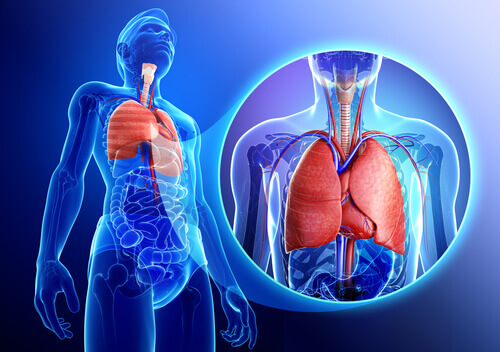Asthma Symptoms, Triggers, and Diagnosis Facts


Reviewed and approved by the doctor José Gerardo Rosciano Paganelli
Asthma is a very complex condition, and involves irritation, inflammation, intermittent obstructions, hypersensitive bronchi or an increased constrictive sensation in your respiratory passages. We’ll be looking at the symptoms of asthma and its diagnosis in today’s article.
There are a large number of asthma patients who have mild or sporadic symptoms. Some, however, tend to have more severe complications known as “asthma attacks”. These cause more severe discomfort and last longer. As a result, breathing becomes more difficult.
Who does asthma affect?

Asthma is present in all countries and can affect people of all ages, although it is more common among children. During this stage, cases of asthma are typically associated with allergies.
See also: Signs you may be lactose intolerant
Causes of asthma
The origin of asthma has never been determined. It’s important, however, to distinguish between etiological factors (such as genetics) and other triggers that may not produce the disease themselves but are responsible for problems in particular patients.
Etiological factors
- Genetics: a family history of asthma and/or allergies related to breathing difficulties
- Exposure to allergens: substances that produce allergies and respiratory symptoms.
The most common ones are:
- Microscopic fungi (a product of moisture)
- Hair from pets
- Fabric (such as wool)
- Smoking
- Sawdust
- Mites
- Dust
- Pollen
Triggers

- Viral infections
- Tobacco smoke
- Celiac disease or gluten intolerance
- Contaminated environments and poor air quality
- Sudden changes in climate (intense cold, humidity, or snow)
- Prolonged use of certain antibiotics and medications
Symptoms of asthma
The different symptoms of asthma may be mild or chronic, depending on the patient. They almost always depend on the strength of your immune system. Although they differ according to the type of asthma you have and its severity, in general a person will experience:
- Coughing: this is typically an irritating cough with little phlegm, sometimes completely dry.
- Difficulty breathing: this happens typically when you’re exercising or exerting yourself physically. In severe cases it may appear while speaking and even at rest.
- Whistling in the chest: these sounds are produced by the passage of air through narrow airways. It is more easily detected by a stethoscope.
Other symptoms to consider include:
- Sensation of fatigue
- Pain and irritation in the throat
- Pressure in the chest
- Irregular breathing (slower or faster than normal)
- Nasal congestion (thick mucus, difficult to eliminate) and sneezing
- Difficulty walking or talking because it’s hard to breathe (a very serious symptom)
We recommend you read: 5 ways to stop a panic attack
Diagnosis of asthma

Many cases are related to allergies, so if a patient has rhinitis or eczema it may lead a doctor to suspect asthma. In addition, the doctor may request any of the following tests to reach a diagnosis:
- Allergy tests
- Blood tests
- Pulmonary function tests
- Chest and sinus X-rays
- Arterial blood gas (when asthma attacks are severe)
Treatment
Unfortunately asthma is a disease that has no cure, but there are certain treatments that can help to control it. The objective of the treatments is to reduce both the severity of your condition and the recurrence of symptoms.
Treatment objectives include:
- Preventing and relieving chronic symptoms, such as coughing and difficulty breathing
- Maintaining proper lung function
- Reducing the need to use emergency medications for relief
- Avoiding chronic asthma attacks
Medical treatments include:
- Anti-inflammatories: corticosteroids are most commonly prescribed (beclomethasone, budesonide, fluticasone)
- Bronchodilators: beta 2 agonists (salbutamol, terbutaline, salmeterol, and formeterol, anticholinergies (ipratropium bromide), and methylxanthines
- Antihistamines: although these don’t control the disease, they are useful for reducing allergy symptoms
It’s also important to have a plan of action that includes the following precautions:
- Firstly, take your medication correctly, at the right time and following medical advice
- Then, seek emergency medical attention when necessary
- Also, know how well your disease is controlled
- In addition to that, avoid environmental triggers
- Lastly, know how to look after yourself when exercising
All cited sources were thoroughly reviewed by our team to ensure their quality, reliability, currency, and validity. The bibliography of this article was considered reliable and of academic or scientific accuracy.
- McGeachie, M. J., Croteau-Chonka, D. C., & Weiss, S. T. (2017). Asthma. In Genomic and Precision Medicine: Primary Care: Third Edition. https://doi.org/10.1016/B978-0-12-800685-6.00013-8
- Global Initiative For Asthma. (2015). Pocket Guide for Asthma Management and Prevention. Global Initative for Asthma. https://doi.org/10.3346/jkms.2008.23.5.772
- Lambrecht, B. N., & Hammad, H. (2015). The immunology of asthma. Nature Immunology. https://doi.org/10.1038/ni.3049
This text is provided for informational purposes only and does not replace consultation with a professional. If in doubt, consult your specialist.








